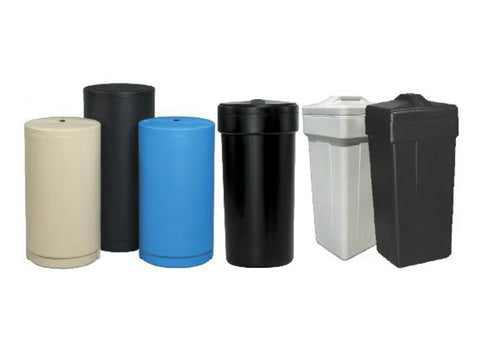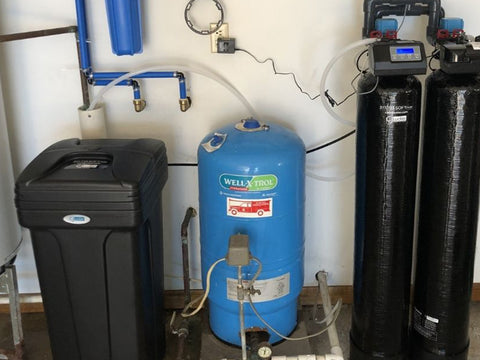The Role of Brine Tanks in Producing Clean and Soft Water
In the world of water purification, Brine Tanks are emerging as key components that not only facilitate, but also strengthen the effectiveness of the overall water purification system.
These specialized tanks, designed to store saline or brine solutions, play a vital role in the regeneration of resins in water softeners-a process that is essential for removing hard minerals such as calcium and magnesium ions from water. The presence of these minerals, if left untreated, can lead to scale formation and various problems in household and industrial appliances.
Therefore, Brine Tanks not only support the water purification process to produce softer and cleaner water, but also help extend the life of the equipment by preventing the accumulation of hard minerals. With capacities and designs tailored to meet the needs of diverse water purification systems, Brine Tanks are at the heart of the regeneration process, ensuring that the water produced complies with quality standards for a variety of daily uses. Through their crucial role, Brine Tanks emphasize the importance of proper selection and maintenance to maintain the efficiency and sustainability of water purification systems.

What is a Brine Tank?
Brine Tank is a tank specifically designed to store salt or brine solution. This solution is then used to regenerate the resin in the water softener, which helps remove calcium and magnesium ions from the water. This process is important to produce clean water that is free from hard minerals that can cause scale and other problems in household or industrial appliances. This tank plays a vital role in maintaining the effectiveness of the water purification system by ensuring that the resin used to filter the water can continue to do its job properly.
The brine solution in the Brine Tank prepares the water softener system for the crucial regeneration process, where sodium ions from the salt solution replace the calcium and magnesium ions that have been trapped by the resin. This restores the resin's capacity to continue the water purification process effectively, ensuring the availability of soft water for daily use. Thus, the Brine Tank contributes to the improvement of water quality, preventing scale formation and extending the life of equipment that uses water in its operation.
The capacity and design of the Brine Tank varies, customized to the size and capacity of the water purification system being used. This ensures that each system can have an adequate supply of saline solution for the regeneration process, according to the frequency and volume of water usage. The tank is designed for easy salt refilling and maintenance, taking into account the need for long-term use and operational efficiency of the water purification system.
Overall, the Brine Tank not only facilitates resin regeneration but also supports the continuous operation of the water purification system, ensuring a clean and soft water supply that meets daily usage needs. Its function and role in the water purification system emphasize the importance of proper Brine Tank selection and regular maintenance to keep the water quality in optimal condition.

How Brine Tanks Work
The way a Brine Tank works is quite simple yet effective. Basically, this tank fills itself with water to a certain level, then the solid salt added to the tank will dissolve in the water. Once the salt solution or brine is ready, the system will flow it into the resin tank where the regeneration process takes place. During this process, calcium and magnesium ions trapped in the resin are replaced with sodium ions from the saline solution, so the resin is "renewed" and ready to filter hard water again.
The process begins when hard water is removed from the tank.
This process begins when hard water enters the system and passes through the resin tank. Here, calcium and magnesium ions in the water are exchanged with sodium ions from the resin, which results in softer water. Once the resin reaches its exchange capacity and is no longer effective in absorbing calcium and magnesium ions, it is time for regeneration. The Brine Tank plays a key role here, by providing the salt solution required for the regeneration process.
The mechanism of filling water into the Brine Tank and dissolving the salt is set up in such a way as to ensure an optimal concentration of the brine solution. When this brine solution is pumped into the resin tank, the rich sodium ions go to work replacing the calcium and magnesium ions that have accumulated in the resin, "cleaning" the resin and restoring its ability to soften water. Once the regeneration process is complete, the excess brine solution and the released calcium and magnesium ions are discharged through the drainage system, and the resin is ready again for the water filtration process.
It is important to pay attention to the quality of the salt.
It is important to pay attention to the quality of the salt used in the Brine Tank, as this directly affects the effectiveness of the regeneration process. Quality salt will dissolve well, creating an efficient brine solution for the regeneration process, while the use of low-quality salt can lead to issues such as salt bridges, which hinder the brine solution creation process and can reduce regeneration efficiency.
Through this effective process, the Brine Tank is able to provide an efficient brine solution for the regeneration process.
Through this effective process, the Brine Tank ensures that the water purification system can continue to work to its full potential, providing soft, quality water for daily needs. With proper maintenance and appropriate material selection, Brine Tanks can support the performance of water purification systems consistently and efficiently.

Importance of Brine Tank in Water Purification System
Brine tanks play a crucial role in maintaining the effectiveness and efficiency of a water purification system. Without a Brine Tank, the ion exchange resin cannot be regenerated and will quickly lose its ability to remove hard ions from the water. This means that the resulting water will remain hard and not ideal for daily needs or certain industrial processes. Therefore, proper maintenance and selection of the right Brine Tank is essential to ensure the water purification system operates at its maximum potential.
The Brine Tank's function in the resin regeneration process is key to maintaining effective water purification performance. Without an efficient regeneration process, the quality of water produced by the purification system will degrade, increasing the risk of scale formation and corrosion of pipes and equipment. In addition, hard water can have a negative impact on health, such as making skin dry and hair coarse, and decreasing the efficiency of soap and detergent use.
Choosing the right Brine Tank according to the capacity and needs of the system is also very important. A tank that is too small may not provide enough saline solution for an effective regeneration process, while a tank that is too large may cause salt and water wastage. In addition, maintenance of the Brine Tank, including regular refilling of salt and cleaning of the tank to avoid contamination or formation of salt bridges, is also vital to maintaining the efficiency of the system.
The importance of the Brine Tank also lies in its role in ensuring the sustainability of the water purification system. By enabling efficient and effective regeneration of the ion exchange resin, Brine Tanks help extend the life of the water purification system, reducing the need for costly component replacements and ensuring a continuous supply of clean and soft water.
A deep understanding of the importance of Brine Tanks also lies in their role in ensuring the sustainability of the water purification system.
Through an in-depth understanding of the importance of Brine Tanks in water purification systems, users can take more care in the maintenance and operation of the system. This not only helps in optimizing the use of purified water for various needs but also supports environmental sustainability by reducing resource usage.

Brine Tank is a vital element in a water purification system that uses ion exchange technology. Its main function is to store the salt solution used for the resin regeneration process, ensuring the system can continue to work effectively in removing hard minerals from water. Proper selection and maintenance of Brine Tanks can increase the longevity of a water purification system and produce clean water that meets quality standards for various needs. Without an efficient Brine Tank, the resin regeneration process will not take place properly, potentially decreasing the quality of the water produced and the effectiveness of the overall purification system.
Watermart as a distributor of water purification equipment in Indonesia provides various solutions to meet the needs of your water purification system, including quality Brine Tanks. We understand the importance of clean and soft water in daily life and industry, and therefore, we are committed to helping you get effective and efficient water purification solutions. With a proper understanding of the components of a water purification system, including Brine Tanks, we are ready to provide the best support and service to ensure your water quality meets the standards you need.
If you are interested in learning more about brine tanks, or need assistance in selecting the ideal brine tank for your specific needs, please feel free to contact us via Whatsapp or e-mail. The Watermart team will be happy to assist you in ensuring access to cleaner, healthier water.

.png?width=50&height=50&name=Logo_Watermart_Perkasa-removebg-preview%20(1).png)


